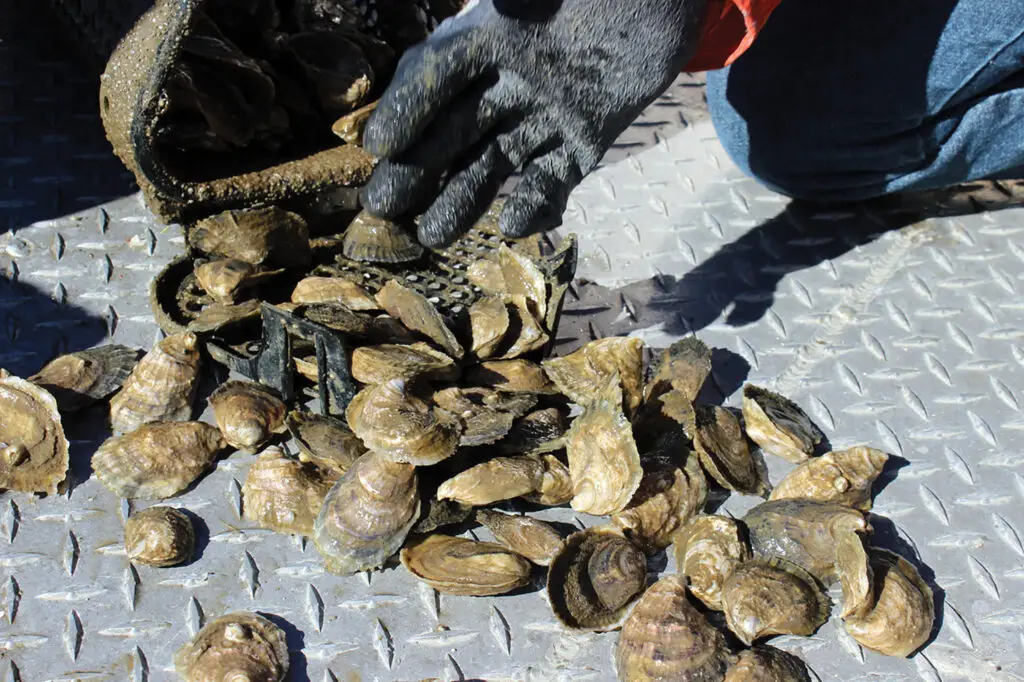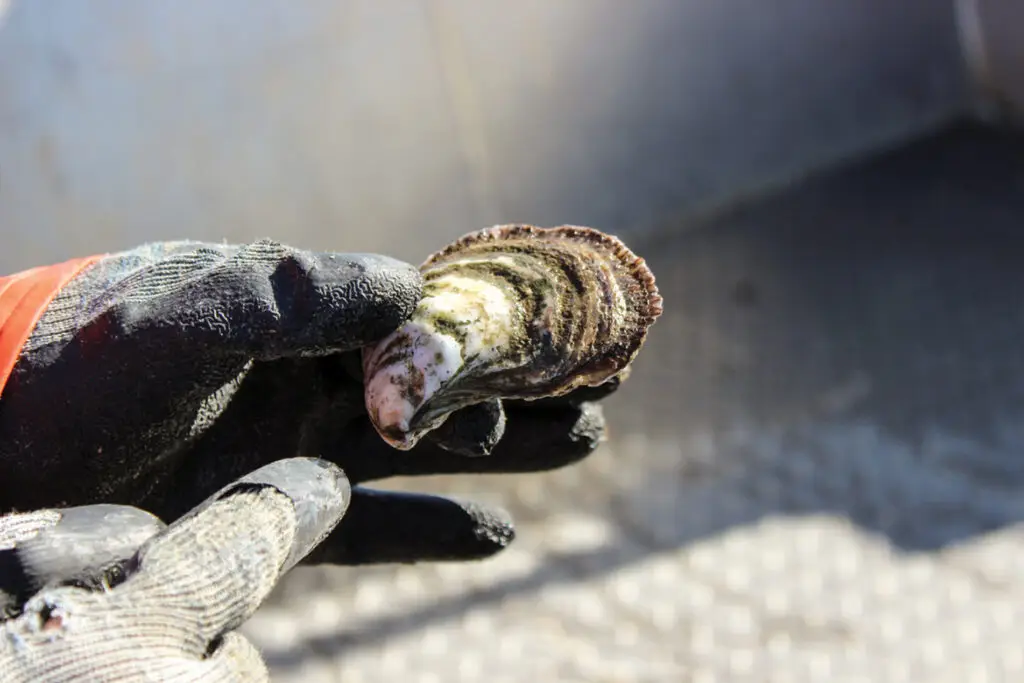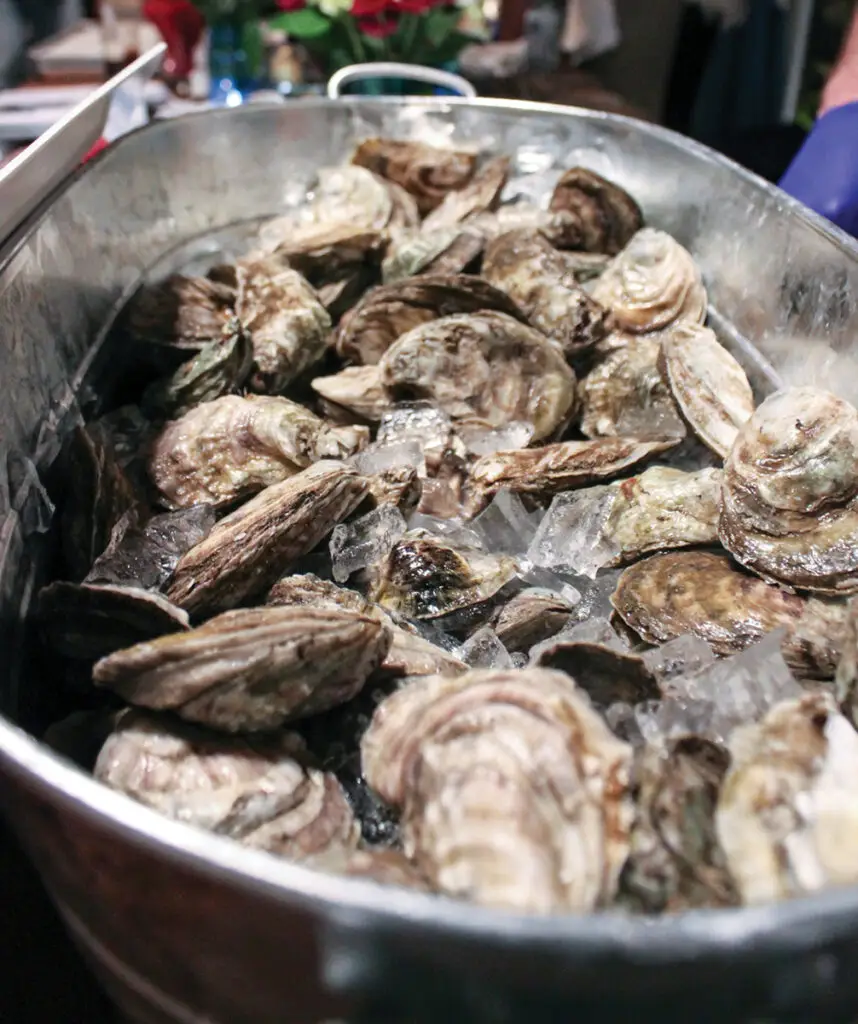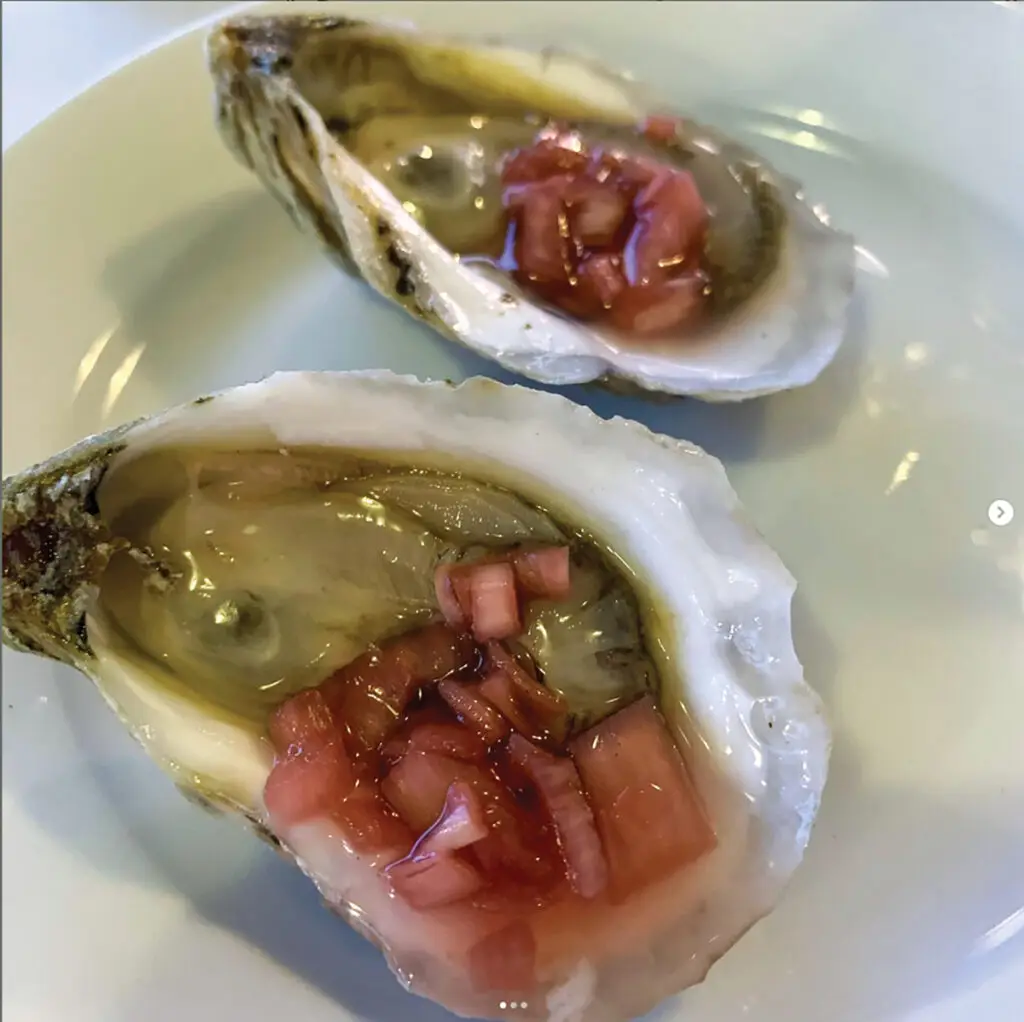Consumer demand drives growth of oyster industry
By Jennifer Kornegay

For most people, there’s not much middle ground when it comes to oysters: You either really like them or you really don’t. And for true oyster fans, the mollusks are more than a meal; they’re an experience, often served at special celebrations and ordered time and time again at favorite restaurants. But whether you consider the bivalve beloved or “bleh,” in Alabama, they’re a seafood staple.
Wild wonders
In Alabama, we harvest and eat one species of oyster: the Eastern Oyster (Crassostrea virginia). But there are two sources of these oysters: wild stock and farms. For the first population, recent years have yielded good news. Following major hurricanes like Ivan (2004) and Katrina (2005) and then years of drought that dropped water salinity levels, the number of wild oysters in Alabama waters plummeted.
“Low salinity means less oysters spawning and more oyster predators, like the oyster drill,” says Col. Scott Bannon, director of Alabama’s Marine Resources. In 2019, the state didn’t even have a harvest season; the status of oysters was that bleak. But then, they made a comeback.
According to Bannon, wild oyster numbers are now on the upswing, evidenced by his department’s seasonal surveys. “I’m hopeful that this season’s results will be similar to the last few years, which have been trending positive thanks to conditions getting right again,” he says. This means more oysters for eating and more opportunities for those who harvest and sell them.

Farm fresh
The number of farmed oysters being grown in Alabama waters is also on the rise. As late as 2009, there were zero oyster farms in Alabama; today, there are approximately 17. Like more robust wild populations, a growing oyster farming industry also means more jobs and a boost for coastal communities’ economies. Plus, these “boutique” oysters are not in competition with the wild stock; they complement it. They are a different product, raised with emphasis on taste and appearance, and most often enjoyed on the half shell, either raw or dolloped with butter and seasonings before being roasted.
Off-bottom oyster farming (also called oyster aquaculture) is the method used by most Alabama oyster farms and differs from raising livestock on land. While farmers do control some aspects of their “crop,” they aren’t feeding them or medicating them. They’re simply protecting them as they grow.
Like most farming, cultivating oysters starts with seed — tiny baby oysters that have been collected from mature oysters after they spawn in facilities called hatcheries. Once in the hands of one of the state’s oyster farms, these still-growing oysters go into the water of Alabama’s coastal bays and inlets, either in baskets strung from lines attached to pilings or in floating cages.

At this point, each farmer uses his own specific methods to tend to his oysters. They may rest in different depths of water, which can impact taste, thanks to ranges in salinity and available food sources. The baskets or cages are turned at different intervals to manipulate the oysters’ cup size (the depth of the shell), which influences the shape of the meat inside and its texture. (Some farms remove the oysters from their baskets and tumble them in a machine to enhance this effect.) Moving the baskets also allows farmers to keep the shells free of barnacles and other pests than can, at worst, harm the oysters and at best, take away from the shells’ natural, unblemished beauty.
The bump up in the number of oyster farms and in the amount of oysters they’re growing is in direct response to heightened consumer demand, says Andrea Tarnecki, Ph.D., an assistant extension professor at Auburn University’s Shellfish Lab. “We’ve been increasing the numbers of farmed oysters harvested as well as their value,” she says.
She credits the growth to the establishment of oyster farming parks that help new farmers get their feet wet, as well as a more streamlined permitting process and resources like alaquaculture.com. “There has been a lot of effort made by state agencies and others to provide training programs, and Alabama’s Marine Resources is supportive of farming,” she says.
One of the oldest and largest oyster farms in Alabama is Murder Point, run by the Zirlott family. They’ve long pulled a living from the Gulf, working as shrimpers, but in 2013 they diversified into oysters and chose the name based on a legend surrounding the farm’s location in Sandy Bay.
“Decades ago, they say a guy killed someone over oyster harvesting rights in this area,” says Lane Zirlott. “And now we say ours are so good they’re worth killing for.”
They may not bring anyone to actual violence, but they are popular, with diners asking for them by name at restaurants around the Southeast and now buying them direct from Murder Point’s two storefronts on Alabama’s Gulf coast. “We’re pushing into the Midwest and up the East Coast a bit too, but really, anywhere you find good food in the Southeast, you’ll probably find us,” Zirlott says.
This year, the farm raised 20 million of its “butter babies,” a phrase used by the Zirlotts to describe the flavor and soft mouth feel of its oysters. And he’s not worried about the market being saturated. “There’s plenty of demand for all the oysters,” he says.
Navy Cove Oysters is also expanding and even offers farm tours to local visitors. Co-owner Chuck Wilson echoed Zirlott. “Alabama has huge potential for farm production and coincident restoration of oyster-elated ecosystem services. The farming community needs to work with state regulators to help that grow,” he says.

Big benefits for all
Lots of oysters — farmed and wild — are not just good for eaters and economies; oysters are key to healthy waters, as Bannon explains. “They are food sources for other species. I call them foundational critters, and they are a vital part of our Gulf ecosystem,” he says. Oyster farms bring additional environmental benefits. Their setups create homes for other marine life, and since oysters are filter feeders, more oysters in the water means more little filters cleaning it; adult oysters filter, on average, approximately two gallons per hour.
Tarnecki agrees and points to the work she and the Shellfish Lab are doing to help. “There’s research going on now to identify best practices for oyster reef restoration and conservation of other coastal habitats, which improves overall water quality,” she says. “There are also efforts in the Gulf working to breed oysters that are more resilient to environmental changes and disease. We have several research projects looking at that right now.”
Aw, shucks!
The populations of both Alabama’s wild and cultivated oysters are strong, but there are challenges facing both. Reefs resting in areas of low dissolved oxygen are a problem for wild oysters. “We’re trying to solve that, creating some high spots for oysters to set to see if they’ll survive better elevated where there is more oxygen,” Bannon says.

He and his team are also helping oyster harvesters become more efficient with an improved oyster management system. “We’ve divided areas into grids, and harvesters can use their smart phone to see which are open or closed,” Bannon says. “It helps us monitor reef health and helps them find the grids that haven’t been hit as hard, maximizing their chances for a good haul.”
For oyster farmers in Alabama, one hurdle is access to quality farming areas. Marine Resources is hoping to partner with Alabama’s state lands division for a fix. “We’d like to allow folks to bid on and lease sections of state property to get the riparian (oyster harvesting or growing) rights off those lands to open up more spots,” Bannon says. “There is potential for more successful oyster farming in Alabama — the demand is there — but we have other issues too, like not enough oyster seed.”
This problem is why Murder Point’s operation is now fully integrated; it has its own hatchery to supply its farm with seed. But it’s not the number one challenge for farmers, according to Zirlott. “Some people still don’t really get what farmed oysters are, and others are still worried about eating oysters raw or eating them in certain months,” he says.
While immune-suppressed people should always be cautious about any raw food, Zirlott stresses how today’s refrigeration technology and strict industry regulations have made the consumption of oysters safer than ever. “It’s just not like the old days,” he says. “And we never cut corners in safety or quality.”
Bannon praises the quality of all Alabama oysters. “I travel around and have tried oysters from all over the country,” he says. “I like our Gulf Coast oysters better than any I’ve had.”
Eat ‘em up

All this oyster info making you hungry? Two oyster-centric events are on Alabama’s autumn agenda.
Montgomery Oyster Festival, 3-7 p.m., Sept. 16 in Montgomery, Old Alabama Town. Check Facebook for details and ticket info.
Experience the Oyster, Nov. 3-4 in Gulf Shores, hangoutcookoff.com
Both invite you to eat your fill of Gulf-farmed oysters. Try them raw and “naked” or sample cooked-oyster creations from some of the South’s best chefs.




